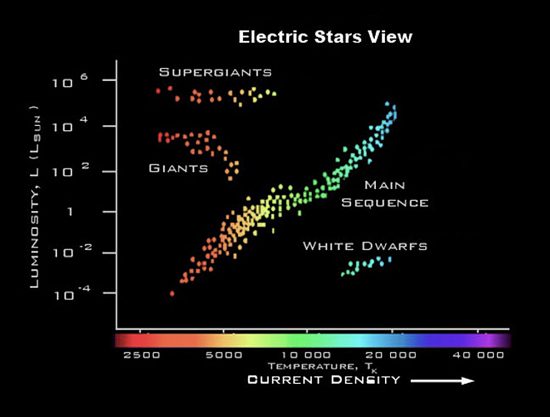
October 6, 2020
Are red giant stars old or young?
“Children will always be afraid of the dark, and men with minds sensitive to hereditary impulse will always tremble at the thought of the hidden and fathomless worlds of strange life which may pulsate in the gulfs beyond the stars…”
— H. P. Lovecraft
Betelgeuse is one of the largest stars ever detected. If it occupied the Sun’s position, its outer envelope would exceed Jupiter’s mean orbital diameter. Its mass is so diffuse, however, that the orbits of the inner planets might not be affected.
Since red giant stars like Betelgeuse are relatively cool but extremely bright, they are interpreted to be large. However, the Electric Star theory proposes that they possess broad coronae. Betelgeuse might be small inside its extended, energetic atmosphere. Its temperature is only about 2900 Celsius, so the thermonuclear model of stars cannot answer why such a cool temperature creates such an extreme radiative output.
According to a recent press release, researchers from the Leibniz Institute for Astrophysics and the Max Planck Institute for Astronomy “discovered confusing red giant stars.” Dr. Saskia Hekker from MPS and the University of Aarhus in Denmark wrote:
“The stars seemed to be old and young at the same time.”
The stars pose a paradox, they are composed of what the researchers call “very old stellar material,” but they appear to be young, because they possess large masses. Red giants are theorized to be old, since the chart of main sequence stars states that they go through a well-established evolution.
That evolution is said to follow a path that depends on thermonuclear fusion: hydrogen gas is compressed in a star’s core until it fuses into heavier elements. Therefore, a star’s mass and its spectrum are thought to indicate its age, because the ratios of different elements is thought to provide an idea of how long it took to convert its original substance into those other elements.
It is believed by consensus astrophysicists that stars accumulate heavier elements as they age. That is said to cause fluctuations in output when temperatures change due to changes in fusion reactions. They turn red as one phase ends, because their atmospheres expand and outflow is spread over a larger area.
That is another in a long list of theories that rely on kinetic effects to explain stellar behavior. The Electric Star theory, on the other hand, proposes a different explanation that relies on the electrical connection that stars have with their galactic neighborhoods. Stars shine because electricity flows through space: stars can be thought of as giant spheres of electrified plasma, an idea that best matches observational evidence
Red giant stars expand in order to collect electrons with a large plasma sheath. As they expand, their electric fields get stronger. Electrons are accelerated to high energies, high enough that neutral particles begin to glow from collisions with negative ions, resulting in a red anode glow. A star’s size, luminosity, and color have little to do with how old it is. A star’s behavior is based on the electric charge flux at its surface. Stars are not powered by internal thermonuclear fusion they are positive anodes in a galactic glow discharge and are powered externally by Birkeland currents.
A red giant’s bright photosphere is a plasma discharge phenomenon subject to electrical pulsations. If this is true then astroseismology applied to the standard model of stars is worthless.
Stephen Smith
The Thunderbolts Picture of the Day is generously supported by the Mainwaring Archive Foundation.












